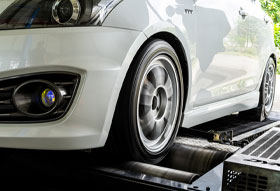
Dynocell soundproofing foam

Given the growing popularity of car customisation and the ongoing interest already well established in car maintenance and testing, we're seeing an increasing number of car garages and dealerships now offering in-house engine testing. More commonly known as 'dyno cell' testing, this enables an individual or dealership team to determine a car's full horsepower in a controlled environment.
A car or other motor vehicle is placed on a rolling road and accelerated in such tests before having its power determined against various testing factors. These factors include a measurement of torque, overall power, and force. Specific parts of a motor vehicle can also be assessed, such as the chassis or engine, with a dynamometer to source data to calculate RPM and horsepower subsequently. Some specialist dyno cells can measure using additional environmental factors to test a vehicle. For example, some have controls over the airflow that a car is exposed to and alternative barometric pressures.
Regardless of the type of testing within a dyno cell, different noise levels and vibration intensities are created. Having a soundproof dyno cell is not yet a legal requirement, although it is highly recommended for employee safety and comfort (and for any friendships with your neighbours!). Those in the control room of a dyno cell also need to communicate easily and accurately, which is easier said than done when dealing with excessive noise and vibration.

Standard practice for the soundproofing of dyno cells includes full acoustic foam insulation for all walls and the ceiling. We highly recommend using Pyrosorb-S foam - a class "0" accredited cellular acoustic foam that is also fire resistant. This is another vital consideration for a test area that involves heat, flammable liquids, and mechanical stress. For the walls, the most effective option is a convoluted foam Pyrosorb-S sheet. Its increased surface area with a wavelike appearance assists with reducing reverberation, sound reflections, and flutter echoes.
Pyrosorb-S foam is also available for ceilings as a whole flat sheet (or smaller sheets) if a more minimal solution is preferred. However, convoluted foam can also be used for ceilings if desired. All acoustic foam ordered from eFoam is of the highest quality and can be cut to size using our online tool. It is also designed to readily work alongside other acoustic barrier layers, supportive facings, and adhesive materials for ease and security of fixing.
It is frequently noted that an appropriately soundproofed dyno cell can reduce sound levels by 40 or more decibels, and using wall and floor acoustic foam is a great starting point. However, sound and vibrations travel through any open spaces – even those as small as gaps in the doorframe. In addition to any foam soundproofing solution, we recommend sealing all window and door frames where possible. For greater sound and vibration reduction, you may also wish to consider the use of corner bass traps for your dyno cell. Bass traps not only help to reduce reverberation and other reflections, but they are also highly efficient in providing maximum absorption in the least space.
For maximised soundproofing, we supply a specialised foam – EPDM, which is another fantastic option that can be used for the floors to assist with sound treatment. It is a fire-resistant, durable foam and widely used in the automotive sector for window & door seals.
For any enquiries relating to the soundproofing of dyno cells, please contact one of our friendly and knowledgeable advisors.

